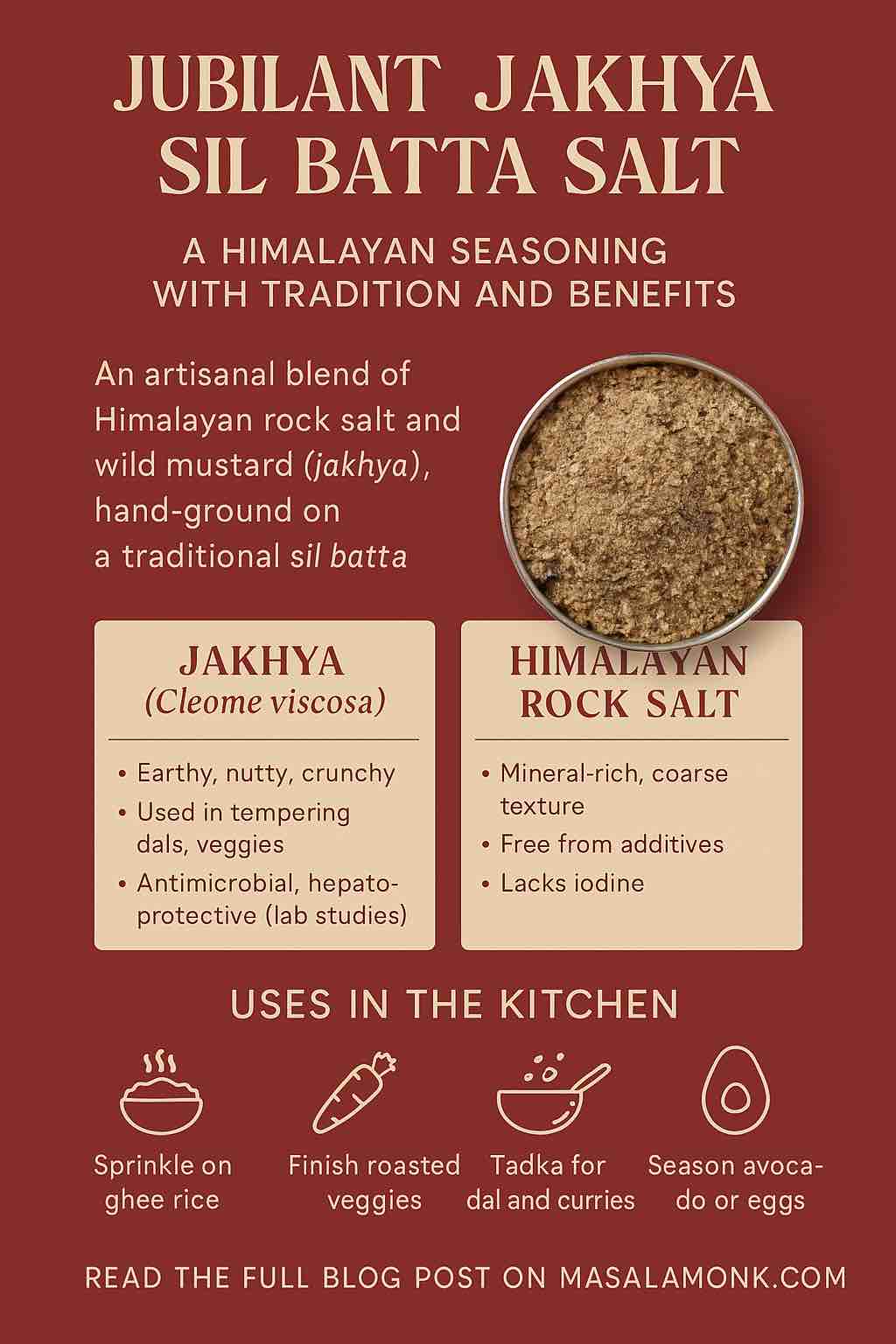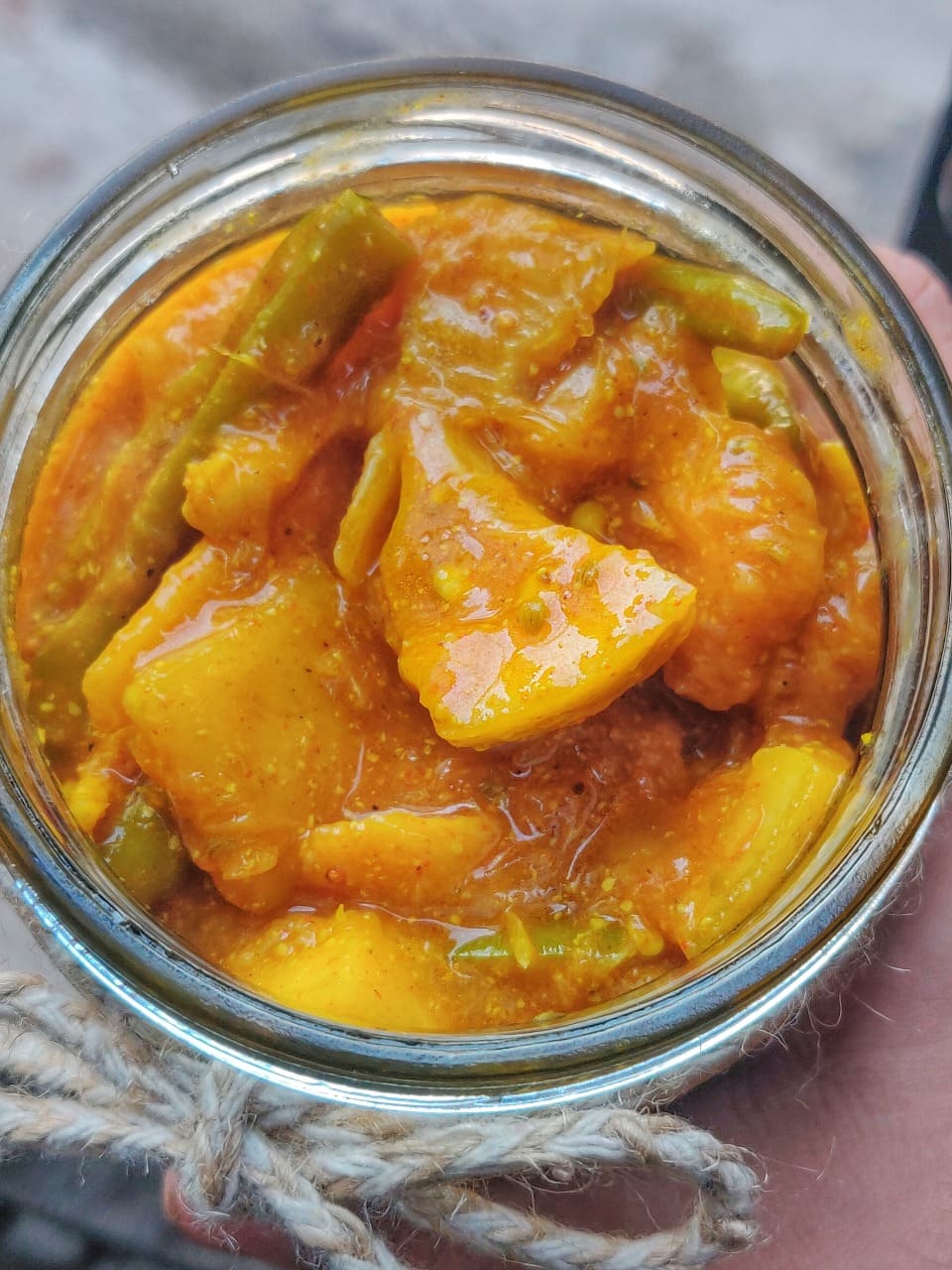
In an age of global cuisine and cutting-edge culinary techniques, it’s ironic that some of the most exquisite flavors come not from high-end restaurants or molecular gastronomy labs, but from the humble hearths of Himalayan villages. There, in the lap of the mountains, generations have seasoned their food with ingredients that are simple, pure, and profoundly flavorful.
One such secret is now accessible to the modern pantry: Jubilant Jakhya Sil Batta Salt, a handcrafted blend of Himalayan rock salt and the nutty, aromatic spice known as jakhya—prepared using the age-old sil batta grinding technique. Available exclusively at MasalaMonk.com, this artisanal blend is more than just a condiment. It’s a piece of culinary history.
👉 Ready to bring the hills into your kitchen?
Order it from MasalaMonk.com and taste tradition today.
Let’s explore what makes this salt special—its ingredients, benefits, scientific backing, and ways to use it in everyday cooking.
🌿 Ingredient Spotlight 1: Jakhya (Cleome viscosa)
➤ What It Is
Jakhya, also known as wild mustard, is a tiny brown seed native to the Garhwal and Kumaon regions of Uttarakhand. Traditionally used as a tempering spice in regional dishes, it is known for its distinctive crackle and nutty aroma when heated in oil.
Despite its rich cultural legacy, jakhya remains underutilized in mainstream Indian cooking—mostly because it’s hard to find outside the hills. Yet, it’s a spice with remarkable properties that go beyond taste.
➤ Traditional Uses
- Tempering dals and vegetables: Common in Uttarakhandi kitchens.
- Preserving food: Thanks to its natural antimicrobial nature.
- Topical applications: Used in traditional medicine for wounds, insect bites, and skin conditions.
➤ Research-Backed Benefits
- Antimicrobial Properties
Studies in the Journal of Ethnopharmacology and Phytotherapy Research show that jakhya seed extracts possess strong antibacterial activity against common pathogens such as E. coli and Pseudomonas aeruginosa. This explains its historical use in food preservation and traditional medicine. - Liver Protection & Antioxidant Activity
Research conducted at institutions like the University of Rajasthan and published in Ancient Science of Life confirmed that extracts of Cleome viscosa helped protect liver cells against chemically-induced damage in lab animals. This hepatoprotective effect is believed to come from antioxidant compounds in the seeds. - Anti-inflammatory and Wound-Healing Effects
A study in the International Journal of Pharmaceutical Sciences and Research showed that a topical gel made from jakhya seeds accelerated wound healing in rats, boosting collagen synthesis and reducing inflammation markers. - Digestive Aid
Folk medicine has used jakhya to treat indigestion, diarrhea, and bloating. This use is supported by the spice’s role in stimulating gastric secretions and easing gut motility.
🧂 Ingredient Spotlight 2: Himalayan Rock Salt
➤ What It Is
Mined from ancient sea beds deep in the Punjab region of Pakistan, Himalayan rock salt is pink-hued and rich in trace minerals. Unlike industrially refined table salt, it undergoes minimal processing and is free from anti-caking agents and bleaching chemicals.
➤ Common Claims & What the Science Says
While many brands advertise Himalayan salt as a “miracle salt,” it’s important to separate fact from hype.
What It Does Offer:
- Contains 80+ trace minerals (calcium, magnesium, iron, zinc)
- Offers natural granulation and texture
- Provides an unrefined alternative to table salt
What It Doesn’t Do (Despite Claims):
- There is no robust clinical evidence that Himalayan salt detoxifies the body or balances pH beyond what any natural salt would do.
- Its trace minerals exist in quantities too small to produce measurable nutritional benefits unless consumed in impractically large amounts (which would be unsafe due to sodium load).
- It does not reduce blood pressure compared to other salts unless it leads to reduced overall sodium intake.
Nonetheless, its natural mineral content, distinct crunch, and lack of additives make it a preferred choice among chefs and health-conscious cooks alike.
🪨 Why Sil Batta Matters
The sil batta is a traditional grinding slab and roller, made of natural stone, used across India for generations before modern mixers and grinders took over.
➤ Why it’s Important in This Salt:
- Stone-grinding is slow and cool, which prevents the loss of volatile essential oils—especially from seeds like jakhya.
- The texture remains coarse and irregular, giving the salt its unique mouthfeel and rustic charm.
- It honors culinary traditions where touch, smell, and rhythm were integral to food preparation.
🧠 Health & Nutritional Perspective
Let’s tie the two ingredients together:
| Property | Jakhya (Cleome viscosa) | Himalayan Rock Salt |
|---|---|---|
| Flavor | Nutty, crunchy, earthy | Mineral-rich, mildly salty |
| Bioactive Benefits | Antimicrobial, anti-inflammatory, antioxidant | Contains trace minerals |
| Digestive Support | Stimulates gastric enzymes | May aid electrolyte balance |
| Traditional Medicine Use | Liver health, skin healing, indigestion | Sinus rinses, cramps (folk uses) |
| Scientific Backing | Preclinical studies validate therapeutic claims | Limited nutritional edge, but minimally processed |
| Modern Culinary Role | Premium tempering seed, finishing spice | Gourmet salt for finishing and texture |
⚖️ Health, Balanced & Mindful
- Jakhya contributes bioactive benefits: antimicrobial, antioxidant, healing—backed by preclinical science.
- Himalayan salt offers texture and trace minerals—but remains a source of sodium requiring mindful consumption.
- Use it as a finishing touch, not a daily seasoning staple—enjoy its flavor and visual delight without overdoing sodium.
🍽️ How to Use & Celebrate It
1. The Ultimate Rice Upgrade
Cook fluffy rice and drizzle with ghee—then finish with a generous sprinkling. The heat brings out oil in the seeds, locking flavor and aroma.
2. Tadka Magic
Add a dash during dal tempering. Experience the jakhya’s crackle and aroma bloom as the oil heats.
3. Spice Up Eggs & Toast
Sprinkle on boiled eggs or smashed avo-toast right before serving—the coarse texture and nutty burst are game changers.
4. Elevate Roasted Veggies & Paneer
Toss veggies or paneer with this blend after pan-frying or oven-roasting, and taste how it transforms simple ingredients.
5. Herbal Finishing Salt
Combine with crushed sesame/flax seeds for a homemade “sprinkle mix” that brings Himalayan charm to any dish.
🎯 Who Is It For?
- Home cooks exploring regional flavors
- Health-conscious eaters wanting artisanal alternatives
- Chefs looking for texture and aroma
- Anyone craving something real, rustic, and rooted
🌍 Why MasalaMonk?
MasalaMonk stands out as a marketplace devoted to artisan food treasures like this one:
- Curated sourcing: Small-scale hill producers maintain traditional processes.
- Ethical transparency: You know where it comes from, how it’s made.
- Authentic small batches: No industrial shortcuts, no preservatives.
Ordering the Jubilant Jakhya Sil Batta Salt from MasalaMonk is a vote for flavour, culture, and heritage.
👉 Ready to bring the hills into your kitchen?
Order it from MasalaMonk.com and taste tradition today.
🛒 Where to Buy
The Jubilant Jakhya Sil Batta Salt is available exclusively at:
👉 https://masalamonk.com/product/jubilant-jakhya-sil-batta-salt/
Handmade in small batches. No preservatives. No shortcuts. Just authentic Himalayan flavor.
📜 Final Thoughts: A Jar Full of Legacy
In a world where most salts are lifeless and most masalas are engineered, Jakhya Sil Batta Salt is refreshingly honest. It reminds us that the best flavor doesn’t come from a lab, but from tradition, patience, and respect for ingredients.
It’s a conversation starter. A quiet teacher. And above all, it’s delicious.
Bring home a jar of this magic—and bring a part of the Himalayas into your everyday meals.
FAQs
- What is Jakhya, and how is it different from mustard seeds?
Jakhya is the seed of the Cleome viscosa plant, native to the Himalayan region. While it resembles mustard seeds in size and behavior (it crackles in hot oil), it offers a more earthy and nutty flavor with subtle bitterness. It’s also known for its digestive and medicinal properties. - Is Himalayan rock salt healthier than regular salt?
Nutritionally, both are primarily sodium chloride. Himalayan salt contains trace minerals like calcium, iron, and magnesium, but in amounts too small to produce significant health effects. Its key benefits are that it is unrefined and additive-free. - Can I use this blend every day?
Yes, but use it mindfully. This is a finishing or flavor-enhancing salt, not a direct substitute for everyday iodized salt. Since it’s not iodized, make sure you’re getting iodine from other dietary sources (e.g., dairy, seafood). - What dishes does this salt pair best with?
It’s incredibly versatile. Use it on steamed rice, boiled eggs, roasted vegetables, tadkas, raitas, dal, avocado toast, or even sliced cucumber and fruits. It works best as a finishing salt or during tempering. - How is this salt different from regular masalas?
This salt isn’t a spice mix—it’s a two-ingredient artisanal blend. It contains pure Himalayan rock salt and wild jakhya seeds, stone-ground using a sil batta to retain oils, aroma, and texture. It’s a seasoning with depth, not just heat or tang. - Is Jakhya scientifically proven to be beneficial?
Yes, several preclinical studies highlight its antioxidant, antimicrobial, hepatoprotective (liver-supporting), and anti-inflammatory properties. It’s been used in traditional medicine for centuries to treat digestive issues, skin wounds, and fevers. - What is the shelf life and storage advice for this product?
It typically has a shelf life of 9 months. Store in a cool, dry place away from moisture, ideally in an airtight glass jar to preserve aroma and texture. - Can I cook with it or just use it raw?
Both! While it shines as a finishing salt, you can also use it during tempering (tadka). The jakhya seeds bloom in hot oil, releasing a rich aroma—perfect for dals, curries, and stir-fries. - Is this product suitable for people with dietary restrictions?
It’s vegan, gluten-free, and free from additives or preservatives. Just be mindful of total sodium intake if you’re on a salt-restricted diet. - Why buy from MasalaMonk.com?
MasalaMonk curates small-batch, artisanal products from regional Indian producers. This ensures authenticity, freshness, and a direct connection to the people who make it—with no industrial processing or dilution of tradition.











